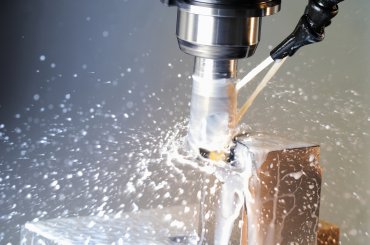Synthetic metalworking fluids are expected to grow at a compound annual rate of 3 percent to 3.5 percent by 2021, according to Kline & Co. consultancy. Not all industry players, however, are convinced synthetic fluids are a superior option to semi-synthetics.
A 2015 study conducted by Caterpillar Inc. found synthetic metalworking fluids have a longer sump life, yield lower operating costs and offer better lubricity than semi-synthetic alternatives.

Photo: Clariant/Flickr
Synthetic metalworking fluid products are valued for their high lubricity, lower additive content, and moderate foaming.
At the time of the study, a Caterpillar facility in East Peoria, Illinois, was primarily using synthetic fluids in shapers, lathes and other less aggressive machining applications. The company found that these fluids offered certain benefits and decided to run two tests comparing the lubricity of mineral oil based semi-synthetic fluids and synthetic fluids to determine whether more applications should be run with synthetics.
I was surprised to see the synthetic showed better lubricity in both lab tests, said Allison Dries, engineering team leader at Caterpillar. Semi-synthetics have traditionally been regarded as more heavy-duty than full synthetics, due to the mineral oil content. Typically, higher oil content is associated with better lubricity, which is why it was surprising to see polymers in synthetic fluid outperform the mineral oil, she noted.
The study determined synthetics to be superior in cleanliness, biostability, chemical maintenance, service life, resistance to rancidity and corrosion protection specifically for machined parts, according to Dries.
Semi-synthetics, however, are better for protecting machining equipment against corrosion. When it comes to extreme machining, wherein extra lubricity or boundary protection is required, the semi-synthetic has the upper hand, said Brian Hovik, market manager at metalworking fluid and additive maker BASF.
Semi-synthetics would generally outperform [synthetics] due to the types of components used, noted Jeffery Mackey, vice president of marketing and business development at Yushiro Manufacturing America. Components like wetting agents and glycol ethers, for example, can cause synthetic fluids to dissolve or degrade seals, he explained.
The big negative with synthetics is that they are hard on the equipment. Theres no oil there to lubricate the machine, and [some fluids can] go after paint, claims Lon Fanning, director of research and development and technical support of metalworking at DuBois Chemicals.
Bacteria in synthetic fluids is not often an issue, which means there is no need to treat the fluids with biocides. Because they dont grow bacteria, said Fanning, they tend to have a very long sump life. A lack of emulsifiers makes the fluids low-foaming, which is important because as sump sizes shrink, pump pressure increases.
The high cost of synthetics is thought to be counteracted by less need for biocides and longer life. Hovik does not believe this to be true. There are numerous semi-synthetic products on the market that provide as long or longer sump life along with no or little need for biocides to remain stable. These semi-synthetics can be acquired at prices at or below the cost for synthetics, he asserted.
Use of synthetic formulations has increased because of growing restrictions on the number of chemicals that can be used in the additization of metalworking fluid formulations. Synthetic products, which are traditionally based on polyalkylene glycol, provide higher lubricity, lower additive content and moderate foaming, making them attractive for use in metalworking fluid formulations. Higher pricing remains a limiting factor, preventing broader demand for synthetic metalworking fluid formulations, explained Kline Project Manager Sharbel Luzuriaga in an interview.
Hovik claims the market is actually shifting away from soluble oils and synthetics towards semi-synthetics because there are many semi-synthetic products on the market that truly provide the best of both soluble oils (lubricity) and synthetics (cleanliness) without sacrificing either tool life or sump longevity and [environmental, health and safety] issues.
In the long run, the semi-synthetic will out-perform the synthetic due to extended tool life and less detriment to the machine tool, fixtures and equipment, and less harsh to employees, predicted Hovik.